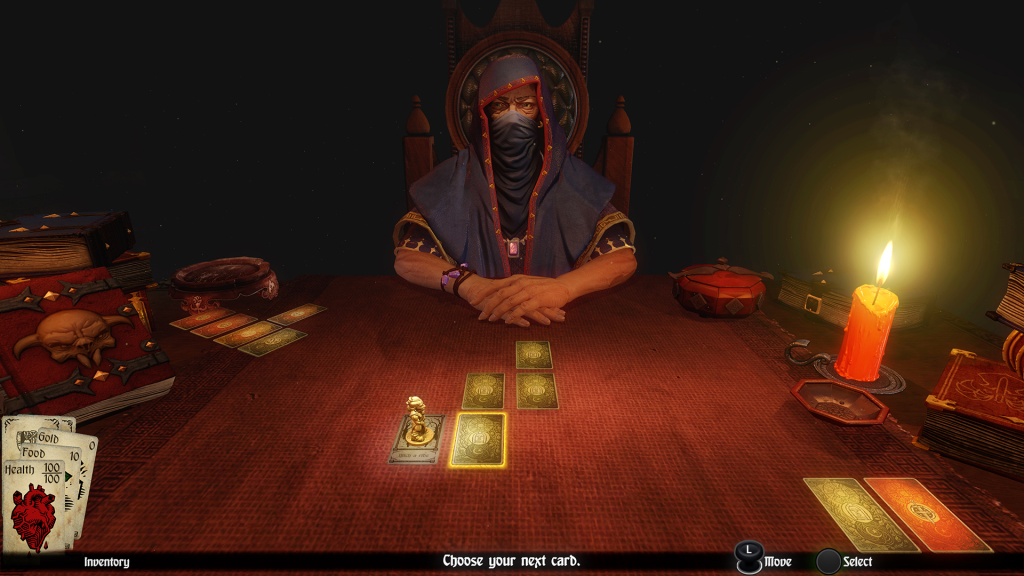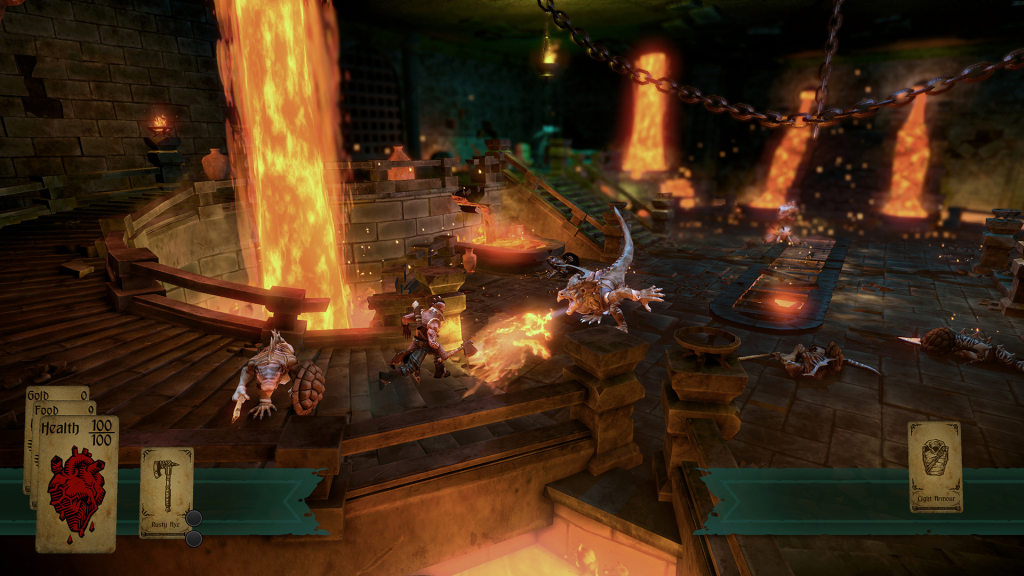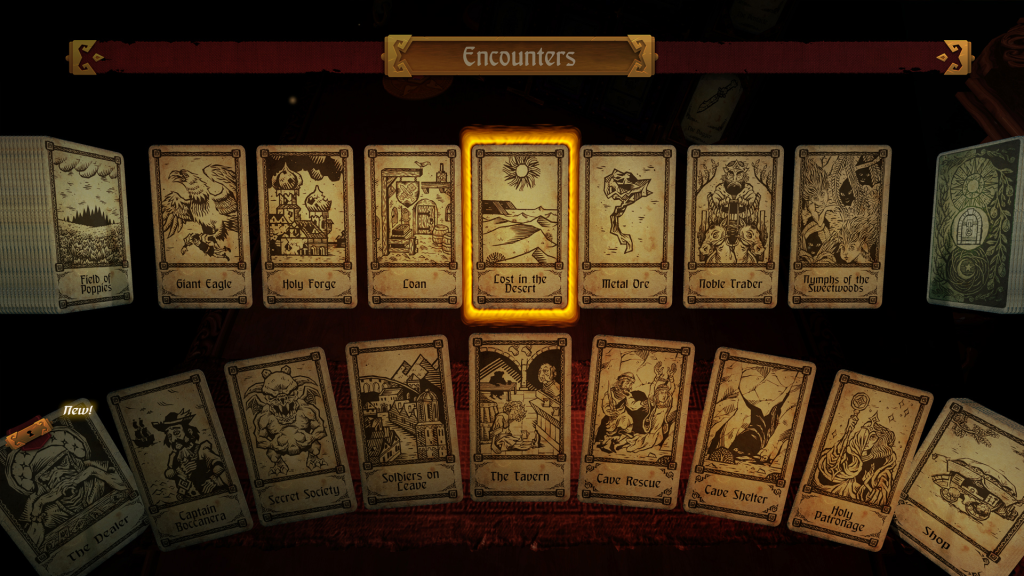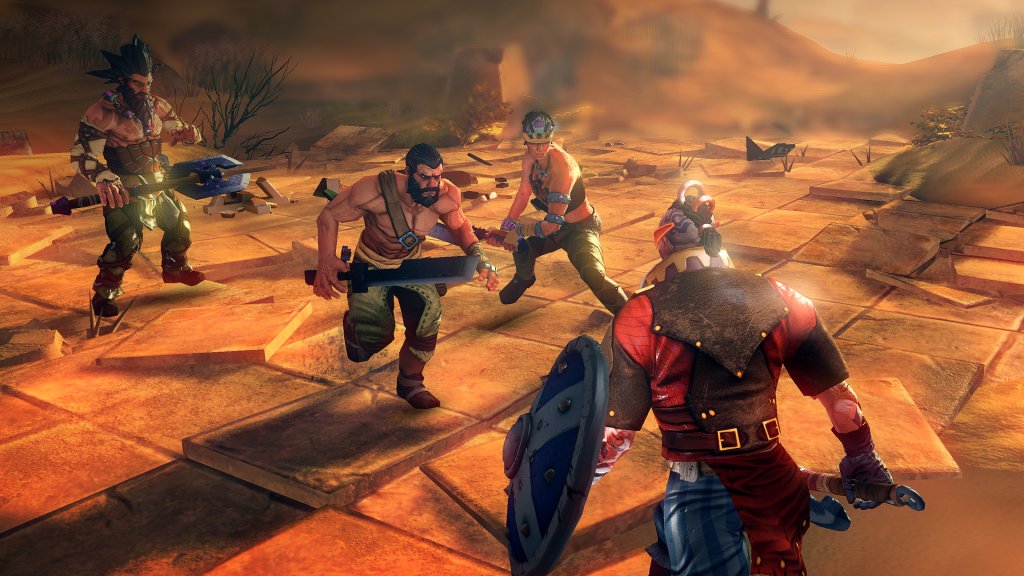
As I made my way across a shallow river, my foot slipped, I cracked my head against a rock and floated downstream on the current. Upon regaining consciousness, I suddenly found myself beset by bandits. How many, you ask? I won’t know until the dealer reveals the next card, but with my luck, it won’t be good for me. In Hand of Fate, a unique blend of deck-building, action-RPG and choose-your-own-adventure, my luck is rarely good.
Hand of Fate is a simple game, really: you assemble a deck of cards, the dealer adds a few of his own and then you must simply survive the hand dealt to you by fate. After you’ve assembled your deck and set off on your chosen adventure. It could be an endless dungeon crawl in which you attempt to outlast the dealer, or the story mode that pits you increasingly difficult dungeons on the way to defeating the dealer’s twelve henchmen — the Jack, Queen and King of each suit — but either way, the cards you picked make up the board.
Each step of your journey lands you on a card that, more often than not, will be an event with a decision to make. Each decision will determine what rewards or punishments are to be doled out. Will you hunt down the bandits that sacked a town? If you find them, will you bring them to justice or join them for a portion of their spoils? Will you give the starving townspeople some of your limited food, which you need in order to progress toward your goal, or pretend to have none and run away? Most of your decisions will be laced with varying levels of risk-vs.-reward. In general, the riskier a decision, the more you will be rewarded, but beware, you could quickly find yourself on the wrong side of fate and a promising run could be snuffed out in a moment.

Of course, Hand of Fate wouldn’t be much of a dungeon-crawler without combat against various enemies. Many encounters, and some failed decisions during events, will result in combat against randomly drawn enemies, both in number and in makeup. One fight may be against just two skeletons, while the next might be against four bandits and six ratmen. The combat mechanics themselves are fairly simplistic and feel almost rhythmic in the heat of battle, much like the Arkham series. There’s one button for attacking, one for blocking and countering attacks, one for dodging and one for stunning enemies with a shield bash. As a result, it’s entirely possible to get into a fight with ten or more enemies and escape without a scratch and, the very next fight, lose half your health to five enemies because you missed a block and counter and lost your rhythm.
As simple as it is, it works because the environments, weapons and various enchantments all feel and look great and mix it up a bit. Some weapons have special abilities, such as a freeze spell, while some arenas have various traps in place ready and willing to hurt or kill you or your opponents. Enchantments can be extra combat skills or provide other utility, such as giving you gold for each kill or letting you reset your health at any point in a fight, but they are all limited in uses.
As I mentioned before, you choose the cards that will make up the dungeon. At first, you’ll have very few cards available to choose from, but each time you play, you’ll unlock more cards. The dealer gets into the act too, adding in his own cards to spice things up. In the early going, he’s more than generous with his beneficial cards, but as story mode progresses, he gets more merciless and ruthless in his contributions. The combination and random layout and ordering of the cards on the board kept things feeling fresh throughout my time playing it.

Visually, Hand of Fate varies in quality a bit. On one hand, the character models, while high-quality, aren’t very crisp or varied, while the environments are detailed and interesting. The cards, though, are obviously the focus, and it pays off in spades, as the art and detail on all of them are impressive and look great. The voice acting and script for the dealer do a great job of immersing you in the setting, with the dealer sometimes seemingly cheering you on, and then turning around and insulting your skills later on. His interactions feel very much like the dungeon master he ultimately is, and they’re a much-appreciated inclusion.
There are, unfortunately, a few minor issues I experienced, though none major enough to affect how I felt about it. For some reason, your personalized settings are not saved across game sessions, so if you turn on subtitles or fiddle with the other settings, you’ll have to do so every time you start. I also experienced a complete crash of the game once when going through the story, but when I started the game up again, it had saved my progress up to that point and it never crashed again, so it doesn’t seem to be anything major. My only real worry regarding Hand of Fate is whether there’s enough variety and content within it to keep me interested past the ten hours or so of the story mode. It’d be easy for Defiant Development to add more content to a game like this, and I hope it does.

Hand of Fate takes a lot of somewhat simple, disparate elements and combines them in a way that I’ve rarely seen, creating that rare title that is much more than the sum of its parts. It works so well, in fact, that I had fun even while my awful luck led me from one painful decision to the next. It only made me more determined to overcome it and defeat fate itself.
Pros: Combat variety, interesting cards, well-done dealer character
Cons: Visual inconsistency, occasional technical issues



















